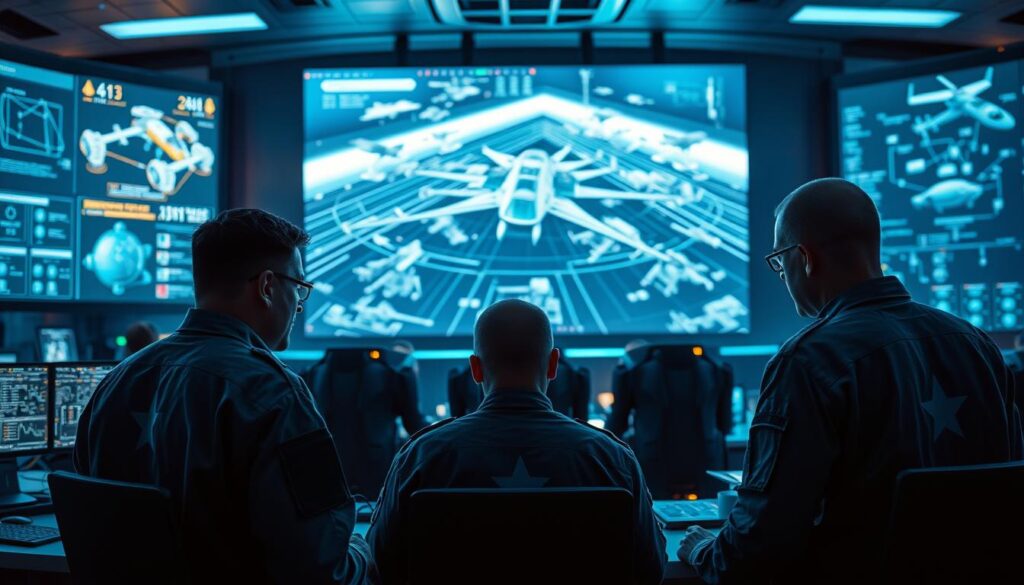What if the most critical weapon in modern defense isn’t a missile or drone—but an algorithm? As global conflicts grow more complex, military alliances face a pivotal question: how can advanced technologies be harnessed ethically while maintaining strategic superiority?
The 2024 strategic update from the transatlantic alliance reveals a bold vision for integrating cutting-edge tools into defense systems. Building on principles established in 2021, recent revisions address emerging challenges like generative systems and competitor advancements. These efforts position the organization as a global benchmark for responsible deployment.
Key developments include certification standards launched in early 2023 and collaborative projects with tech partners. This approach balances innovation with accountability, ensuring systems enhance decision-making without compromising ethical guardrails. The framework prepares members for evolving threats while shaping international norms.
Key Takeaways
- Updated 2024 strategy strengthens ethical guidelines for defense technologies
- Certification programs ensure interoperability across member nations
- Collaboration with academia and industry drives innovation
- Focus on generative systems addresses next-gen security challenges
- Balances tactical advantages with legal and moral considerations
Understanding NATO AI initiatives and Their Strategic Impact

The transformation of military tactics hinges on invisible systems processing vast data streams. Since 2021, the transatlantic coalition has systematically refined its approach to emerging technologies, balancing rapid innovation with ethical accountability.
From Framework to Implementation
Initial guidelines published in late 2021 laid groundwork for responsible technological integration. By February 2023, certification standards began unifying member states’ capabilities. Specialized committees like the Data and AI Review Board emerged to oversee ethical deployment.
“The capabilities of these technologies have continued to evolve at an ever more rapid pace,”
Modernization Priorities
Current efforts concentrate on three pillars:
- Cross-border system compatibility
- Shared data quality protocols
- Ethical usage benchmarks
| Focus Area | 2021 Strategy | 2024 Updates |
|---|---|---|
| Interoperability | Conceptual framework | Testing phase with 18 nations |
| Data Standards | General principles | Mandatory validation processes |
| Ethical Compliance | Voluntary guidelines | Certification requirements |
These advancements draw insights from member states’ experiments, including collaborative planning tools tested in multinational exercises. The approach prevents fragmented national solutions while maintaining collective security objectives.
Technological Advancements Shaping Modern Defense
How do invisible networks of data processing redefine battlefield success? Cutting-edge systems now analyze real-time intelligence, predict threats, and coordinate responses faster than human operators alone. These innovations reshape how militaries approach strategic planning and tactical execution.
Enhancing Decision-Making Through Advanced Tools
Modern defense systems leverage sophisticated algorithms to process battlefield data at unprecedented speeds. Command centers utilize these technologies to identify patterns in logistics, troop movements, and resource allocation. A 2023 multinational exercise demonstrated that forces using advanced tools reduced response times by 40% compared to traditional methods.
“Effective implementation requires continuous dialogue between software engineers and field commanders—neither side can work in isolation.”
Bridging the Interoperability Divide
Seamless communication between diverse military platforms remains a critical hurdle. Legacy systems often struggle to share operational data with newer technologies, creating potential gaps in situational awareness.
| Challenge Type | Technical Obstacle | Current Solution |
|---|---|---|
| System Integration | Incompatible data formats | Standardized middleware protocols |
| Data Quality | Varying sensor accuracy | Cross-nation calibration standards |
| Human-Machine Dynamics | Overreliance on automated alerts | Hybrid decision frameworks |
Recent studies highlight that poorly integrated technologies can amplify operational confusion rather than reduce it. For example, incompatible threat assessment models between allied forces led to conflicting recommendations during joint exercises last year. This underscores the need for coordinated development cycles involving both technical and military experts.
Responsible Use, Ethical Considerations, and Emerging Trends
How can military alliances ensure advanced technologies serve humanity rather than undermine it? The answer lies in robust ethical frameworks that evolve alongside technical capabilities. Recent strategic revisions prioritize transparency and accountability while navigating complex moral landscapes.
Guiding Principles for Military Applications
Six core tenets form the foundation of defense technology governance. These include requirements for lawful deployment, system reliability, and bias reduction. The 2024 updates transform voluntary guidelines into enforceable benchmarks through certification processes.
| Principle | 2021 Approach | 2024 Enhancements |
|---|---|---|
| Lawfulness | General compliance | Legal review protocols |
| Explainability | Basic documentation | Real-time audit trails |
| Governability | Manual override options | Automated kill switches |
Cross-Sector Partnerships
The alliance bridges gaps between theoretical research and practical implementation. Technology firms contribute advanced analytical tools, while universities provide ethical risk assessments. Joint working groups address challenges like algorithmic transparency in weapon systems.
“Our collective security depends on merging technical expertise with moral clarity.”
Preparing for Tomorrow’s Challenges
Generative systems and autonomous platforms demand proactive policy reforms. Current efforts focus on harmonizing standards with civilian regulations like the EU AI Act. However, voluntary adoption mechanisms create inconsistencies across member states’ infrastructure.
Future strategies must address dual-use technologies that blur military-civilian boundaries. Continuous research partnerships will prove critical in maintaining strategic advantages while upholding shared values.
Conclusion
Defense strategies now face a critical juncture where technological potential must align with operational reality. The alliance’s multi-layered approach demonstrates how collaborative frameworks can transform advanced tools into security assets rather than sources of confusion.
Success hinges on balancing technical capabilities with human oversight. As recent analyses highlight, decision-making frameworks require rigorous testing across diverse scenarios. Shared data protocols and standardized interfaces remain vital for achieving meaningful interoperability.
Long-term outcomes depend on sustained efforts to merge innovation with ethical governance. While technologies offer transformative possibilities, their military application demands continuous refinement of human-machine collaboration models. Properly implemented systems enhance information processing without replacing strategic judgment.
The road ahead involves addressing both technical hurdles and organizational dynamics. Cross-border partnerships, like those leveraging strategic planning tools, provide blueprints for scalable solutions. By prioritizing responsible use and adaptive strategies, collective security mechanisms can evolve alongside emerging threats.







